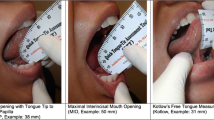Abstract
Aim
Ankyloglossia or tongue-tie is a congenital condition of newborns when the inferior lingual fraenulum is too short and is attached to the tip of the tongue limiting its movement. The aim of this study was to evaluate the relationship between ankyloglossia classification and tongue mobility. In addition, the prevalence of ankyloglossia among males and females was assessed.
Methods
300 subjects (150 boys and 150 girls) with an age range of 7–12 years were randomly selected from different schools. The distance between the uppermost point of lingual fraenulum and its insertion into the oral floor was measured in the subjects. The subjects were categorised from having no ankyloglossia to severe tongue-tie based on the measurements.
Results and conclusion
This study showed that ankyloglossia was more common in males. It also showed that only subjects with a lingual fraenulum of <1.5 cm suffered from inadequate tongue movement.
Similar content being viewed by others
References
Ballard JL, Auer CE, Khoury JC. Ankyloglossia: assessment, incidence, and effect of frenuloplasty on the breastfeeding dyad. Pediatrics. 2002;110:e63.
Garcia Pola MJ, Gonzalez Garcia M, Garcia Martin JM, Gallas M, Seoane Leston J. A study of pathology associated with short lingual frenum. ASDC J Dent Child. 2002;69(59–62):12.
Griffiths DM. Do tongue ties affect breastfeeding? J Hum Lact. 2004;20:409–14.
Harris EF, Friend GW, Tolley EA. Enhanced prevalence of ankyloglossia with maternal cocaine use. Cleft Palate Craniofac J. 1992;29:72–6.
Hogan M, Westcott C, Griffiths M. Randomized, controlled trial of division of tongue-tie in infants with feeding problems. J Paediatr Child Health. 2005;41:246–50.
Horton CE, Crawford HH, Adamson JE, Ashbell TS. Tongue-tie. Cleft Palate J. 1969;6:8–23.
Jorgenson RJ, Shapiro SD, Salinas CF, Levin LS. Intraoral findings and anomalies in neonates. Pediatrics. 1982;69:577–82.
Klockars T. Familial ankyloglossia (tongue-tie). Int J Pediatr Otorhinolaryngol. 2007;71:1321–4.
Kotlow LA. Ankyloglossia (tongue-tie): a diagnostic and treatment quandary. Quintessence Int. 1999;30:259–62.
Lalakea ML, Messner AH. Ankyloglossia: does it matter? Pediatr Clin North Am. 2003;50:381–97.
Messner AH, Lalakea ML. Ankyloglossia: controversies in management. Int J Pediatr Otorhinolaryngol. 2000;54:123–31.
Messner AH, Lalakea ML, Aby J, Macmahon J, Bair E. Ankyloglossia: incidence and associated feeding difficulties. Arch Otolaryngol Head Neck Surg. 2000;126:36–9.
Mukai S, Mukai C, Asaoka K. Congenital ankyloglossia with deviation of the epiglottis and larynx: symptoms and respiratory function in adults. Ann Otol Rhinol Laryngol. 1993;102:620–4.
Proffit WR, Mason RM. Myofunctional therapy for tongue-thrusting: background and recommendations. J Am Dent Assoc. 1975;90:403–11.
Ricke LA, Baker NJ, Madlon-Kay DJ, DeFor TA. Newborn tongue-tie: prevalence and effect on breast-feeding. J Am Board Fam Pract. 2005;18:1–7.
Ruffoli R, Giambelluca MA, Scavuzzo MC et al. Ankyloglossia: a morphofunctional investigation in children. Oral Dis. 2005;11:170–4.
Segal LM, Stephenson R, Dawes M, Feldman P. Prevalence, diagnosis, and treatment of ankyloglossia: methodologic review. Can Fam Physician. 2007;53:1027–33.
Wright JE. Tongue-tie. J Paediatr Child Health. 1995;31:276–8.
Conflict of interest
The authors declare that they have no conflict of interest.
Author information
Authors and Affiliations
Corresponding author
Rights and permissions
About this article
Cite this article
Jamilian, A., Fattahi, F.H. & Kootanayi, N.G. Ankyloglossia and tongue mobility. Eur Arch Paediatr Dent 15, 33–35 (2014). https://doi.org/10.1007/s40368-013-0049-0
Received:
Accepted:
Published:
Issue Date:
DOI: https://doi.org/10.1007/s40368-013-0049-0




